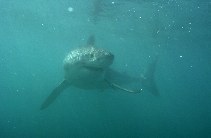|
Carcharodon carcharias
Great white shark |
|
||||
| Carcharodon carcharias (Linnaeus, 1758) | ||||
| Family: | Lamnidae (Mackerel sharks or white shark) | picture (Cacar_ue.jpg)
by
Zsilavecz, G.
Map |
||
| Order: | Lamniformes (mackerel sharks) | |||
| Class: | Elasmobranchii (sharks and rays) | |||
| FishBase name: | Great white shark | |||
| Max. size: | 720 cm TL (male/unsexed; Ref. 13574); max. published weight: 3,400.0 kg (Ref. 26340); max. reported age: 36 years | |||
| Environment: | reef-associated; oceanodromous; brackish; marine ; depth range 0 - 1280 m | |||
| Climate: | subtropical; 60°N - 50°S, 180°W - 180°E | |||
| Importance: | fisheries: minor commercial; gamefish: yes | |||
| Resilience: | Very low, minimum population doubling time more than 14 years (K=0.06; tm=8-12; tmax=36; Fec=7) | |||
| Distribution: Gazetteer |
Cosmopolitan, mostly amphitemperate. Western Atlantic: Newfoundland, Canada to Argentina; also north Gulf of Mexico, Bahamas, Cuba and Lesser Antilles (Ref. 26938). Eastern Atlantic: France to South Africa, including the Mediterranean. Indian Ocean: Red Sea, Seychelles, South Africa; also Reunion and Mauritius (Ref. 33390). Western Pacific: Siberia to New Zealand and the Marshall Islands; also south Australia (Ref. 26938). Central Pacific: Hawaii. Eastern Pacific: Alaska to Chile. International trade cooperation, Australia (CITES Appendix III, since 28.5.2003). | |||
| Diagnosis: | Dorsal spines (total): 0-0; Anal spines: 0-0. A huge, spindle-shaped shark with conspicuous black eyes, a blunt, conical snout and large, triangular, saw-edged teeth (Ref. 5578). First dorsal-fin origin usually over the pectoral-fin inner margins (Ref. 43278, 6871). Caudal fin crescentic (Ref. 247). Lead-grey to brown or black above, lighter on sides, and abruptly white below (Ref. 6851). Black spot at rear pectoral fin base (Ref. 6851). | |||
| Biology: | Primarily a coastal and offshore inhabitant of continental and insular shelves, but may also occur off oceanic islands far from land (Ref. 247). Often close inshore to the surf line and even penetrates shallow bays (Ref. 247). Usually solitary or in pairs but can be found in feeding aggregations of 10 or more; does not form schools (Ref. 247). Feeds on bony fishes, sharks, rays, seals, dolphins and porpoises, sea birds, carrion, squid, octopi and crabs (Ref. 5578) and whales (Ref. 32140). Ovoviviparous, embryos feeding on yolk sac and other ova produced by the mother (Ref.50449). Reported by some experts to attack humans which they mistake for their normal prey (Ref. 47). Most attacks occur in estuaries. Caught by big-game anglers and line boats for its jaws (Ref. 5578). Reported to cause poisoning (Ref. 4690). Flesh is utilized fresh, dried-salted, and smoked for human consumption, the skin for leather, liver for oil, carcass for fishmeal, fins for shark-fin soup, and teeth and jaws for decorations (Ref. 13574). Possibly to 8 m in length, considered the world's largest predator with a broad prey spectrum. The record of 10.98 m is incorrect (Ref. 13574). Sometimes considered the most dangerous shark in the world (Ref. 26938). | |||
| Red List Status: | Vulnerable, see IUCN Red List (A1cd+2cd) , Fergusson, I., Compagno, L. & Marks, M. , (Ref. 36508) , Rationale: The white shark is a widely but sparsely distributed top predator with a very low reproductive potential (late maturity and small litter size) and high vulnerability to target and bycatch fisheries (commercial and recreational), some of which supply high-value products (fins, jaws and teeth) for international trade. Notoriety of this shark as an ultimate Hollywood monster encourages inflated values for white shark products, and encourages illicit trade in white shark parts that is difficult to assess and control. Where detailed population data are available, these indicate that the abundance and average size of white sharks have declined. The species is now protected in some parts of its range, where it may be Lower Risk/conservation dependent, but the effectiveness of such protection is questionable where enforcement is weak. A global status of Endangered (A1cd+2cd) may be proven accurate for this shark as further data is collated. | |||
| Dangerous: | traumatogenic , Compagno, L.J.V.. 1984 | |||
| Coordinator: | Compagno, Leonard J.V. | |||
| Main Ref: | Compagno, L.J.V.. 1984. (Ref. 247) | |||
|
Update | Add | Get XML file | Point data in XML | Common names in XML |
||||
Return to Fish Base
 /
/